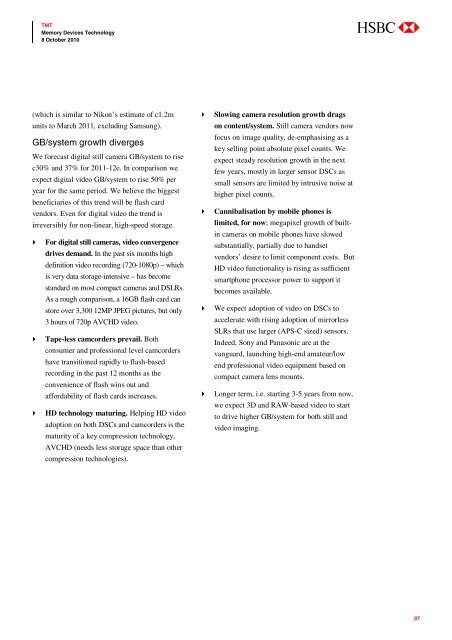Create successful ePaper yourself
Turn your PDF publications into a flip-book with our unique Google optimized e-Paper software.
TMT<br />
<strong>Memory</strong> Devices Technology<br />
8 October 2010<br />
abc<br />
(which is similar to Nikon’s estimate of c1.2m<br />
units to March 2011, excluding Samsung).<br />
GB/system growth diverges<br />
We forecast digital still camera GB/system to rise<br />
c30% and 37% for 2011-12e. In comparison we<br />
expect digital video GB/system to rise 50% per<br />
year for the same period. We believe the biggest<br />
beneficiaries of this trend will be flash card<br />
vendors. Even for digital video the trend is<br />
irreversibly for non-linear, high-speed storage.<br />
For digital still cameras, video convergence<br />
drives demand. In the past six months high<br />
definition video recording (720-1080p) – which<br />
is very data storage-intensive – has become<br />
standard on most compact cameras and DSLRs.<br />
As a rough comparison, a 16GB flash card can<br />
store over 3,300 12MP JPEG pictures, but only<br />
3 hours of 720p AVCHD video.<br />
Tape-less camcorders prevail. Both<br />
consumer and professional level camcorders<br />
have transitioned rapidly to flash-based<br />
recording in the past 12 months as the<br />
convenience of flash wins out and<br />
affordability of flash cards increases.<br />
HD technology maturing. Helping HD video<br />
adoption on both DSCs and camcorders is the<br />
maturity of a key compression technology,<br />
AVCHD (needs less storage space than other<br />
compression technologies).<br />
Slowing camera resolution growth drags<br />
on content/system. Still camera vendors now<br />
focus on image quality, de-emphasising as a<br />
key selling point absolute pixel counts. We<br />
expect steady resolution growth in the next<br />
few years, mostly in larger sensor DSCs as<br />
small sensors are limited by intrusive noise at<br />
higher pixel counts.<br />
Cannibalisation by mobile phones is<br />
limited, for now; megapixel growth of builtin<br />
cameras on mobile phones have slowed<br />
substantially, partially due to handset<br />
vendors’ desire to limit component costs. But<br />
HD video functionality is rising as sufficient<br />
smartphone processor power to support it<br />
becomes available.<br />
We expect adoption of video on DSCs to<br />
accelerate with rising adoption of mirrorless<br />
SLRs that use larger (APS-C sized) sensors.<br />
Indeed, Sony and Panasonic are at the<br />
vanguard, launching high-end amateur/low<br />
end professional video equipment based on<br />
compact camera lens mounts.<br />
Longer term, i.e. starting 3-5 years from now,<br />
we expect 3D and RAW-based video to start<br />
to drive higher GB/system for both still and<br />
video imaging.<br />
37
















